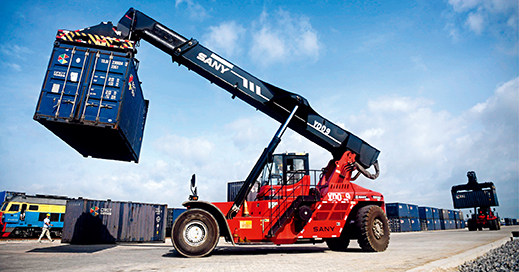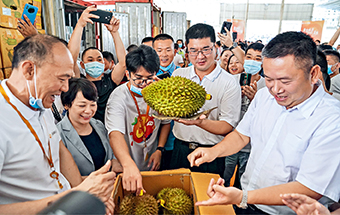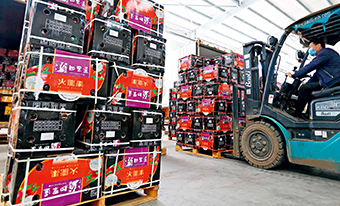The New International Land–Sea Trade Corridor (ILSTC), formerly known as the “China-Singapore Southern Transport Corridor,” was jointly launched in 2017 by China and Singapore under the Singapore-China (Chongqing) Demonstration Initiative on Strategic Connectivity (CCI). Since its inception, China has fostered great expectations for the ILSTC to help tackle unbalanced development between its coastal east and inland west and explore new growth points and models to adapt to its slowing economic development. Singapore is looking to the deal to consolidate free trade and regional connectivity against the current wave of anti-globalisation and protectionism. Both sides expect the linkage initiative to connect not only western China to Singapore, but the vast Eurasian continent to the ASEAN region, which, according to discourse on China’s Belt and Road Initiative (BRI), represent the Silk Road Economic Belt and the 21st Century Maritime Silk Road.
But since the outbreak of Covid-19, no clear blueprint or grand plan has emerged to meet the terms of the ILSTC mentioned in the joint agreement between China and Singapore, which has significantly hindered progress on the initiative. And this is after regional supply chains were severely interrupted by the spreading pandemic.
Beibu Gulf Port (in Guangxi Zhuang Autonomous Region) in the western part of ILSTC, however, reported single-day loaded carriages of 407 on August 2, 2020, with a total of 16 container trains departing the port, an impressive surge of growth that bucked the trend. On August 5, a freight corridor connecting Puzhai port in China and Tan Thanh border gate in Vietnam officially began operation, and a parking lot serving the international freight corridor connecting China and Vietnam through the Friendship Pass was officially opened. Pinxiang City of the Guangxi Zhuang Autonomous Region announced accelerated construction on several major projects including the expansion and transformation of Naning-Pingxiang section of the Hunan-Guangxi Railway and the Chongzuo-Pingxiang intercity railway. Pinxiang is committed to becoming a hub for ASEAN cross-border transportation to promote ILSTC connectivity.
With the ASEAN+3 region taking the lead in stabilizing pandemic infection and resuming economic activity, the ILSTC, with well-recognized potential, could leapfrog from conceptual exploration to concrete results.
Further Opening-up
Internationally, the ILSTC is considered a component of the BRI, a large-scale transnational infrastructure connectivity-oriented plan. The BRI consists of two parts, a land-based Silk Road Economic Belt covering mainly Central Asia, and a 21st Century Maritime Silk Road running throughout Southeast Asia. The two parts converge in the vast western China wilderness. Plans as ambitious as today’s ILSTC have been years in the making due to a need to develop the necessary infrastructure for cross-region connectivity, as evidenced by the earlier version of the ILSTC, known as the Southern Transport Corridor. Smaller than the BRI but with more concentrated efforts, and noticeably focused on sustainable development and pragmatic cooperation in the mainland ASEAN sub-region, the Lancang-Mekong Cooperation (LMC) jointly promoted by China and mainland ASEAN countries since 2014 has also been coupled with the ILSTC. The ILSTC would contribute to several of the LMC’s prioritized areas including connectivity, cross-border economic exchange, and production capacity cooperation.
The ILSTC’s foreign partner, Singapore is well-known for its international branding and business expertise in logistics, finance, and law. China hopes to learn from its strengths to explore new economic growth models to usher its western regions into a future of sustainable prosperity and connect the BRI’s two components as an integrative whole. With China’s continued reaffirmation of determination to further open up and the country’s unrelenting efforts to build free trade zones, physical and logistical connectivity as well as the potential spill-over effects of software integration brought by the ILSTC are anticipated to drive the China-ASEAN Free Trade Area, China-Singapore Free Trade Agreement (CSFTA), the potential Regional Comprehensive Economic Partnership and China-Japan-Korea Free Trade Area.
Domestically, the ILSTC is a policy in line with a decades-long go-west campaign with the objective of tapping on the economic potential of western China. In terms of industrialization and urbanization, the rapidly developing eastern seaboard of China is two decades ahead of the inland west, almost reaching developed countries’ income levels. Tackling such unbalanced development between east and west, the latter of which accounts for two-thirds of China’s territory, China has been constantly encouraging domestic and foreign businesses to move inland under the banner of “go-west.” Initially, the practice was simply to encourage the western provinces to imitate the successful path of eastern provinces featuring labor-intensive and resource-consuming activities like manufacturing. When the economic and environmental sustainability of the eastern provinces came into question around the turn of the century, consensus started shifting to western China exploring new growth models and becoming a new driving force for China’s path to the Two Centenary Goals, one of which was to eradicate poverty by the end of 2020. Subsequently, the other aim is make China a modern socialist country by the mid-21st century to mark the centenary of the People’s Republic of China.
In this vein, the ILSTC, first launched as an international initiative in 2018, was incorporated by China’s National Development and Reform Commission into the domestic go-west campaign in 2019, as marked by the introduction of the New Western Land-Sea Corridor (NWLC). Set high on western China’s development agenda, the NWLC is well complemented by various national strategies. One supportive national strategy is the development of the Yangtze River Economic Zone which was introduced in 2016. Its inspiration was the Yangtze River which flows across China, naturally linking the most prosperous downstream eastern regions like Shanghai, Jiangsu, and Zhejiang to the less developed middle- and upper-stream regions like Hubei, Hunan, Chongqing, Sichuan, Yunnan, and Guizhou. The zone is expected to revive the industrial, supply and value chains along the river, eventually helping bring coastal prosperity to the hinterland. Alongside individually focused measures, these strategies have been clearly written in the legally-binding national and related provincial five-year plans adopted by the national and related provincial people’s congresses, with top level directories guaranteeing effective and coordinated implementation.
Facilitating Connectivity
Guided by high-level strategies, a series of facilitating technical policies have been laid out to acutely implement strategic concepts. The central component of the ILSTC is trans-modality transport, which requires both trans-border infrastructure integration and administrative coordination capable of delivering seamless container transport between the waterways, airways, rails, and roads. Such connectivity is expected to empower the ILSTC route with a 10-day advantage in transportation speed compared to the conventional route along the Yangtze River. Penetration rate of trans-modality transport in China is still low compared to Western industrialized economies, with China’s trans-modality transport accounting for only 2.9 percent of shipments compared to over 30 percent in Western advanced countries. In 2016, 18 Chinese ministerial agencies jointly launched a nationwide scheme to promote trans-modality, standardizing regulatory rules, charged fees, and transport unit sizes. Plans to integrate parallel administrative systems, government databases and transport patterns were also developed.
Another facilitating policy is the China-Europe Express Railway, an intercontinental transportation service stretching from China all the way to cities throughout Western, Central, and Eastern Europe. Initially championed by European market-oriented emerging manufacturing hubs in western China such as Chongqing and Sichuan in 2011, the railway scheme was soon elevated and added to plans of the central government. Three places were designated along the borders of China’s Xinjiang and Inner Mongolia to serve three lines of the railway serving western, central and eastern China, respectively. Construction of the railway consumed tremendous resources because the rail standards and customs rules of different countries and sub-jurisdictions along the route vary. At first, the railway mainly transported China’s comparatively advantaged manufacturing and agricultural products to high-demand European markets, but the effects soon spilled over into mainland ASEAN countries. For example, Vietnam’s manufacturing products have often been carried by the express train from the border area near China all the way to Europe, which is much faster in speed and barely more expensive than the trans-ocean waterway.
Unprecedented Provincial Coordination
China’s economic success over the past four decades since reform and opening-up was introduced has been largely associated with vibrant and proactive province-led development. China’s provincial regions geographically bordering Southeast Asia—Guangxi, Yunnan, and Guizhou—began more actively engaging with Southeast Asian countries in the 1990s with a going-out strategy. Guangxi, officially designated China’s gateway to ASEAN, has been hosting the annual China-ASEAN Expo and China-ASEAN Business and Investment Summit since 2004. The event was once one of only three national level expos in China and remains a major platform for economic cooperation to this day. Competing for access to Southeast and South Asia, Yunnan organized its own expo under the name of China-South Asia Expo, which attracted Southeast Asian businesses and investment as well. Guizhou taps its potential in education and cultural exchange to organize China-ASEAN Education Cooperation Week every year. With China’s reaffirmed prioritization of cooperation with ASEAN and the lay-out of the CCI and ILSTC, Chongqing, Sichuan, Ningxia, and other western provinces joined ASEAN-oriented opening-up as well. Ningxia, well-known for its large Muslim population, expanded its China-Arabic States Expo to halal producers and consumers in Southeast Asian Muslim countries and regions. Chongqing set up an international logistics park to serve connectivity with ASEAN, and Sichuan established industrial parks in cooperation with Singapore.
By its nature, the ILSTC requires inter-provincial coordination, and it has indeed resulted in signing of several memoranda of understanding among involved provincial governments. In October 2019, 12 western provinces, the offshore island province of Hainan, and Zhanjiang City in south China’s Guangdong Province met to discuss joint building of the ILSTC, marking the formulation of 13+1 inter-jurisdiction coordination. Through this platform, all domestic stakeholders have been working on integrating systems, standardizing rules, and establishing matching services including finance and law-enforcement. Provinces have also been issuing their own action plans. Gansu, Guangxi, Guizhou, and Sichuan have circulated policies to motivate all agencies to keep working on building the ILSTC. This was the first time China saw such large-scale inter-provincial coordination.
ASEAN’s Strategic Development Landscape
Singapore has been taking the lead of the ILSTC. China and Singapore have been working together since 1994 on Suzhou Industrial Park, Tianjin Eco-city, and other projects. The ILSTC represents a new chapter of bilateral cooperation. Singapore sees the ILSTC as a response to trade protectionism and slowing globalization. Singapore expects the ILSTC’s synergy with the RCEP and CSFTA to kindle economic growth across China’s western regions by enhancing connectivity between the regions and with the world through the fastest and cheapest routes to facilitate freight and logistics flow. Accordingly, Singapore is also working with China on the Chongqing Logistics Development Platform (CLDP), a Multi-Modal Distribution and Connectivity Centre, and other initiatives and organizations.
The ILSTC is also designed to reach other ASEAN countries. Building on the connections created by the BRI and focused on aligning with various ASEAN countries’ national strategies, the ILSTC is well-suited to adapt to a fluid regional development agenda. For mainland ASEAN countries, Thailand’s East Economic Corridor aims to industrialize and connect its three eastern provinces. Vietnam’s Two Corridors and One Economic Circle taps the potential of its two border areas connecting to China’s Yunnan and Guangxi. Cambodia’s Rectangular Strategy and Lao PDR’s goal of transforming from a land-locked to land-linked country both prioritize inter-regional connectivity. Among oceanic ASEAN countries, Indonesia’s Global Maritime Axis strategy aims to make the country a global maritime power by championing maritime connectivity and commerce, and the Philippines’s AmBisyon Natin 2040 represents collective long-term vision and aspirations of the Filipino people to seize prosperity through several paths including connectivity. Every regional country’s strategy includes a dimension of connectivity and advocates regional integration and prosperity, as does the ILSTC.
Launched in 2017, the ILSTC is already more than two years old. By the end of 2019, hundreds of companies from China, Singapore, and other countries had participated in the project. However, various issues have still constrained the ILSTC from reaching its full potential in physical and software connectivity, and ultimately trade volume and value. Issues include misunderstandings of policy narratives and discourse between China and Singapore, different practices of business and policies, and administrative and technical difficulties in sharing data and information. Such factors have also prevented the ILSTC from getting a comprehensive blueprint to make the attractive strategic concepts initially endorsed by China and Singapore concrete reality, even after issuance of so-called domestic match-up policy, the New West China Land-Sea Trade Corridor.
To economically revive the region in the current stage of pandemic-induced recession, it is worth looking to the original vision of the ILSTC to link various fragmented policies and strategies of Chinese provinces and ASEAN countries and facilitate urgently needed reforms. Now could be the time to realize the full potential of the ILSTC.
About the author Hao Nan holds a Master’s degree in public policy from Lee Kuan Yew School of Public Policy at the National University of Singapore. He now serves as an Assistant Research Fellow at the Charhar Institute in China.
407 loaded carriages
16 container trains
Beibu Gulf Port (in Guangxi Zhuang Autonomous Region) in the western part of ILSTC reported single-day loaded carriages of 407 on August 2, 2020, with a total of 16 container trains departing the port, an impressive surge of growth that bucked the trend.

A worker at Qinzhou Railway Container Terminal uses a truck crane to lift a container on June 30, 2019. (ZHANG AILIN)

Mayor of Pingxiang Wu Xiaohui (center) holds a durian at the Fresh Jiangnan Trade Fair for ASEAN Fruits, which opened in Pingxiang, Guangxi Zhuang Autonomous Region, on July 29, 2020. (CHEN GUANYAN)

A worker at a trade center for agricultural products in Qingdao, Shandong Province, unloads dragon fruits arriving from Vietnam on April 27, 2020. (LIANG XIAOPENG)
L0063.T001.JPG
Penetration rate of trans-modality transport in China is still low compared to Western industrialized economies, with China’s trans-modality transport accounting for only 2.9 percent of shipments compared to over 30 percent in Western advanced countries.


 Copy Reference
Copy Reference